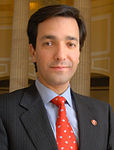| |||||||||||||||||||
|
| |||||||||||||||||||
Gubernatorial election | |||||||||||||||||||
| Turnout | 78.11% | ||||||||||||||||||
|---|---|---|---|---|---|---|---|---|---|---|---|---|---|---|---|---|---|---|---|
| |||||||||||||||||||
 Results by municipality Padilla: 40-50% 50-60% Fortuño: 40–50% 50–60% | |||||||||||||||||||
| |||||||||||||||||||
Resident Commissioner election | |||||||||||||||||||
| |||||||||||||||||||
 Results by municipality Pierluisi: 40-50% 50-60% Alomar: 40–50% 50–60% | |||||||||||||||||||
| |||||||||||||||||||
| Elections in Puerto Rico |
|---|
 |
General elections were held in Puerto Rico on Tuesday, November 6, 2012, to elect the officials of the Puerto Rican government that would serve for the next four years, most notably the Governor of Puerto Rico.[1] A status referendum was held on the same date.
The gubernatorial elections were won by then-Senator Alejandro García Padilla from the Popular Democratic Party (PPD), who defeated incumbent governor Luis Fortuño from the New Progressive Party (PNP) in a close election. This election marked the second time in more than 40 years that six parties participated in the election, the first time in more than 60 years that a status referendum was held on the same day as the general election, and the first time in Puerto Rico that absentee ballots were issued for those who were out of the country on the day of the election.[2] As of 2024, this was the most recent time a member of the Popular Democratic Party won the governorship of Puerto Rico, and the last time a Republican did so.
In the elections for Resident Commissioner, incumbent Pedro Pierluisi of the PNP (who caucused with the Democratic Party and who was first elected in 2008, narrowly won reelection for a second term.[3] Pierluisi defeated his closest opponent, Rafael Cox Alomar of the PPD by almost 1.3%.[3]
- ^ "Electoral Calendar - international elections world elections". Retrieved May 12, 2011.
- ^ Díaz, Carmen (June 24, 2012). "Elección para la historia". El Vocero. Archived from the original on July 6, 2012. Retrieved September 15, 2012.
- ^ a b "Puerto Rican Governor Luis Fortuno loses re-election". Voxxi. November 7, 2012. Archived from the original on September 29, 2013. Retrieved November 10, 2012.



